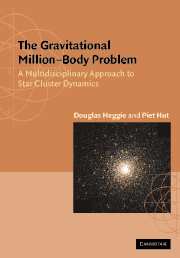Book contents
- Frontmatter
- Contents
- Preface
- PART I INTRODUCTIONS
- PART II THE CONTINUUM LIMIT: N → ∞
- PART III MEAN FIELD DYNAMICS: N = 106
- PART IV MICROPHYSICS: N = 2
- PART V GRAVOTHERMODYNAMICS: N = 106
- PART VI GRAVITATIONAL SCATTERING: N = 3
- PART VII PRIMORDIAL BINARIES: N = 4
- 24 Binaries in Star Clusters
- 25 Triple Formation and Evolution
- 26 A Non-Renewable Energy Source
- PART VIII POST-COLLAPSE EVOLUTION: N = 106
- PART IX STAR CLUSTER ECOLOGY
- Appendix A A Simple N-Body Integrator
- Appendix B Hints to Solution of Problems
- References
- Index
24 - Binaries in Star Clusters
Published online by Cambridge University Press: 05 June 2012
- Frontmatter
- Contents
- Preface
- PART I INTRODUCTIONS
- PART II THE CONTINUUM LIMIT: N → ∞
- PART III MEAN FIELD DYNAMICS: N = 106
- PART IV MICROPHYSICS: N = 2
- PART V GRAVOTHERMODYNAMICS: N = 106
- PART VI GRAVITATIONAL SCATTERING: N = 3
- PART VII PRIMORDIAL BINARIES: N = 4
- 24 Binaries in Star Clusters
- 25 Triple Formation and Evolution
- 26 A Non-Renewable Energy Source
- PART VIII POST-COLLAPSE EVOLUTION: N = 106
- PART IX STAR CLUSTER ECOLOGY
- Appendix A A Simple N-Body Integrator
- Appendix B Hints to Solution of Problems
- References
- Index
Summary
In the original Star Wars movie there is a brief but memorable scene of two stars shining down from the afternoon sky. We find it striking because we are so used to seeing just a single star in the sky, but in fact it is the Sun that is unusual. In the neighbourhood of the Sun most stars are binaries, and some belong to triple systems or even little groups with still larger numbers of stars (Duquennoy & Mayor 1991). Our nearest neighbours, for example, are a binary (α Centauri) with a distant third companion (Proxima Centauri, see Matthews & Gilmore 1993). Such systems are unlikely to arise by chance encounters (Problem 1), and so the abundance of binaries and triples suggests that most stars are born that way. Indeed binaries and other multiples are most common among the youngest stars (see Kroupa 1995).
A brief observational history
With this background, astronomers were perplexed by how difficult it was to find any binaries in globular star clusters. Admittedly, wide visual pairs were not expected, as such binaries would be destroyed by encounters with other stars in the dense environment of a globular cluster (Problem 21.1). Indeed, there is observational evidence that this has happened (Côté et al. 1996). But it should have been possible to detect closer binaries by observing periodic variations in their radial velocity, or else through the discovery of eclipsing variable stars.
- Type
- Chapter
- Information
- The Gravitational Million–Body ProblemA Multidisciplinary Approach to Star Cluster Dynamics, pp. 230 - 235Publisher: Cambridge University PressPrint publication year: 2003

